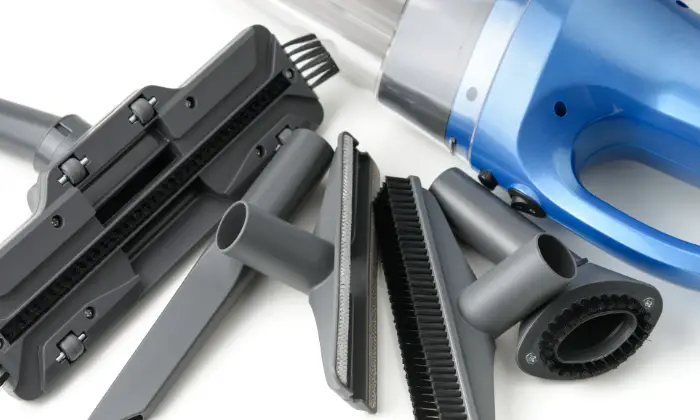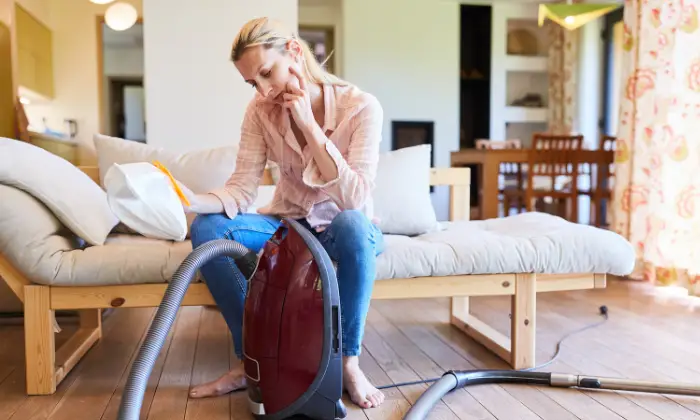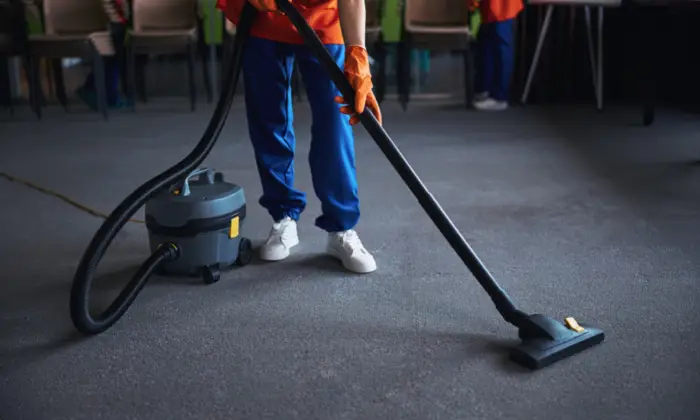
Cleaning is a breeze when you have the right tool, & there’s no denying that vacuums are an indispensable part of our daily life cleaning. But have you ever felt curious to know about the inner workings of your vacuum cleaner?
In this article, we’ll show you the different parts of a vacuum cleaner. We will explore their functions & how they all come together to make vacuuming a walk in the park. 🙂
So, Read on and find out what makes your vacuum cleaner tick!
Parts of a Vacuum Cleaner: Explore the Essential Parts & Inner Workings

To better understand your vacuum, let’s break down its essential components and learn how they contribute to its overall performance.
The Mighty Motor
The heart of any vacuum cleaner is its motor. It generates the necessary suction power by spinning a fan that creates airflow. The motor’s size and power will determine the vacuum cleaner’s efficiency and suction strength.
The Business End: Suction Head
The suction head, also known as the cleaning head or nozzle, is part of the vacuum cleaner that directly touches the surface being cleaned. It features an opening through which dirt and debris are drawn into the vacuum. Different suction heads are available, each designed for specific cleaning tasks.
The Backbone: Vacuum Tubes and Hoses
The vacuum tubes and hoses connect the suction head to the vacuum’s main body. They are essential for maintaining a consistent airflow and providing a path for the dirt and debris to travel to the dustbin or vacuum bag.
Wheels and Casters: Mobility at Its Finest
Vacuum cleaners wouldn’t be helpful if they couldn’t quickly move around your home. Wheels and casters provide your vacuum with the mobility it needs to navigate various surfaces and tight spaces rapidly.
Filters: Keeping the Air Clean
A vacuum cleaner is only complete with its filters. These critical components trap dust, allergens, and other microscopic particles, ensuring that the air expelled from the vacuum is clean and safe to breathe.
Pre-motor Filter
The pre-motor filter protects the motor from dust and debris, ensuring it doesn’t become clogged and overheat. This filter is typically washable and should be cleaned regularly for optimal performance.
Post-motor Filter
The post-motor filter, often a HEPA filter, traps microscopic particles and allergens before the air is released back into your home. This filter is crucial for maintaining a healthy indoor environment.
Dustbin or Vacuum Bag: A Place for Dirt to Rest
Vacuum cleaners collect dirt and debris in a dustbin or a vacuum bag. Bagless vacuum cleaners feature a dustbin that can be quickly emptied and cleaned, while bagged vacuums require the regular replacement of vacuum bags.
Power Cord and Automatic Cord Rewind
The power cord provides electricity to the vacuum cleaner, while the automatic cord rewind feature allows for hassle-free storage. This handy feature retracts the power cord with a button, keeping it tucked away until it’s needed again.
Attachments and Accessories: Versatility at Your Fingertips

A vacuum cleaner’s true potential is unlocked through various attachments and accessories, which enhance its versatility and cleaning capabilities.
Crevice Tool
The crevice tool is a narrow, elongated attachment perfect for cleaning tight spaces, corners, and edges.
Dusting Brush
The dusting brush is a soft-bristle attachment designed for gently cleaning delicate surfaces like blinds, lampshades, and bookshelves.
Upholstery Tool
The upholstery tool is a vast, flat attachment perfect for cleaning sofas, chairs, mattresses, and other fabric-covered surfaces.
Extension Wand
The extension wand is a long tube that connects to your vacuum’s hose, allowing you to reach high or difficult-to-access areas, like ceilings and upper shelves.
Vacuum Cleaner Types and Their Unique Parts

Various types of vacuum cleaners are available, each with unique components that cater to specific cleaning needs.
Upright Vacuums
Upright vacuums are the most common type of vacuum cleaner. They feature a powerful motor, a rotating brush roll for deep carpet cleaning, and an ergonomic design for comfortable, upright use.
Canister Vacuums
Canister vacuums feature a separate motor and dustbin unit connected to the cleaning head via a flexible hose. They offer excellent manoeuvrability and are suitable for cleaning various surfaces, including carpets, hard floors, and above-floor areas.
Stick Vacuums
Stick vacuums are lightweight, slim, and cordless, perfect for quick cleanups and small living spaces. They typically include a rechargeable battery and may have a detachable handheld vacuum for versatile cleaning.
Robotic Vacuums
Robotic vacuums are automated cleaning devices that use advanced sensors and navigation systems to clean your floors without manual intervention. They often include scheduling features, smartphone app control, and advanced mapping capabilities.
Handheld Vacuums
Handheld vacuums are compact, portable devices for quick cleanups and spot cleaning. They’re perfect for cleaning small spills, upholstery, and hard-to-reach areas.
Maintenance: Ensuring Longevity and Optimal Performance
Regular maintenance is essential to keep your vacuum cleaner running smoothly & efficiently. This includes emptying the dustbin or replacing vacuum bags, cleaning filters, and checking for any wear or damage to the vacuum’s parts.
FAQs: Get the Answers You Need
Q. What is the most essential part of a vacuum?
The Suction Motor: The suction motor is arguably the most crucial component of a vacuum cleaner. It creates vacuum pressure and suction by rotating a motor fan, known as the impeller, at an incredibly high speed of about 30,000 to 35,000 RPM. The suction motor’s power and efficiency determine the vacuum cleaner’s overall performance, making choosing a vacuum with a reliable and robust engine essential.
Q. What is the bottom part of a vacuum called?
The Power Nozzle (or Power Head): Located at the base of most vacuum cleaners, the power nozzle (also known as the power head) is responsible for agitating and lifting dirt and debris from surfaces. Many power nozzles offer brush roll height adjustment capabilities, effectively cleaning various floor types, from bare floors to deep-pile carpeting. The design and efficiency of the power nozzle significantly impact the vacuum cleaner’s ability to clean different surfaces.
Q. What are the four uses of vacuum cleaners?
Vacuum cleaners serve various purposes, making them versatile and essential cleaning tools. Some of the primary uses of vacuum cleaners include:
- Floor Cleaning: Vacuum cleaners effectively remove dirt and dust from various surfaces, including hardwood, laminate, tile, and carpeted floors.
- Upholstery and Furniture Cleaning: They can also clean upholstery, velveteen furniture, and fabric-covered items, removing dust, pet hair, and allergens from these surfaces.
- Car Cleaning: Vacuums come in handy when cleaning the interiors of cars, removing dirt, crumbs, and debris from seats, carpets, and hard-to-reach crevices.
- Stair Cleaning: Vacuum cleaners, especially lightweight and portable models, are ideal for cleaning stairs, making the task less cumbersome and more efficient.
Based on these uses, vacuum cleaners come in various types, each designed for specific cleaning needs & preferences.
Q. What are the various attachments on a vacuum cleaner?
Vacuum cleaner attachments are designed to enhance your vacuum’s versatility and cleaning capabilities. Here are some common extensions and their purposes:
- Crevice Tool: This narrow, elongated attachment is perfect for cleaning tight spaces, corners, and edges. It’s great for reaching between sofa cushions, baseboards, and other narrow areas.
- Dusting Brush: The dusting brush features soft bristles designed for gently cleaning delicate surfaces such as blinds, lampshades, and bookshelves. This attachment is also helpful for dusting electronic equipment and keyboards.
- Upholstery Tool: Upholstery is a broad, flat attachment designed to clean sofas, chairs, mattresses, and other fabric-covered surfaces. It’s ideal for removing pet hair and lint from upholstery.
- Extension Wand: The extension wand is a long tube that connects to your vacuum’s hose, allowing you to reach high or difficult-to-access areas, such as ceilings, upper shelves, and tall furniture.
- Turbo Brush or Power Brush: This attachment features a rotating brush roll that is either air-driven (turbo brush) or powered by a separate motor (power brush). It’s perfect for deep cleaning carpets, picking up pet hair, and revitalizing high-pile carpet fibers.
- Bare Floor Brush: The essential floor brush is designed for cleaning hard surfaces, such as hardwood, tile, and laminate flooring. It features soft bristles or microfiber pads to cleanse and protect your floors from scratches gently.
- Flexible Crevice Tool: Similar to the standard crevice tool, it is designed to reach tight spaces but features a flexible design that allows it to bend around corners and access more challenging areas.
Each vacuum cleaner model may come with unique attachments, so it’s essential to consult your owner’s manual or the manufacturer’s website to understand the specific extensions available for your vacuum cleaner.
Q. How often should I clean or replace the filters in my vacuum cleaner?
It depends on the type of filter and the manufacturer’s recommendations. Pre-motor filters should typically be cleaned every 3-6 months, while post-motor filters may need replacement every 6-12 months.
Q. Can I use my vacuum cleaner on wet surfaces?
Unless you have a wet-dry vacuum specifically designed for picking up liquids, you should avoid using your vacuum cleaner on wet surfaces, as it could damage the motor and other internal components.
Q. Why is my vacuum cleaner losing suction?
Loss of suction could be due to a clogged filter, a full dustbin or vacuum bag, or a blockage in the hose or suction head. Regular maintenance should help prevent these issues.
Q. Can I use my vacuum cleaner without a filter?
Using a vacuum cleaner without a filter is not recommended, as it could damage the motor and allow dust and allergens to be released back into your home.
Q. How often should I replace my vacuum cleaner’s belt?
Most vacuum cleaner belts should be replaced every 12-18 months, depending on usage and wear. Check your owner’s manual for specific recommendations.
Q. Are all vacuum cleaner attachments universal?
Not all attachments are universal. Some vacuum cleaners have unique connections or require specific extensions designed for their model. Check your owner’s manual or the manufacturer’s website for compatibility information.
Conclusion
Now that you’re familiar with the various parts of a vacuum cleaner and its functions, you can better understand and maintain your vacuum for optimal performance.
With regular care and maintenance, your vacuum cleaner will continue to be a reliable cleaning companion, making your home a cleaner, healthier environment for you and your loved ones.
============================================
Feel free to follow us on Linkedin: House Stopper





